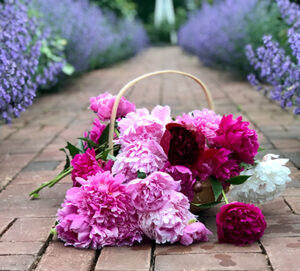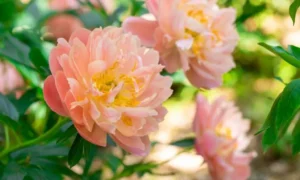“Are you ready to be mesmerized by the beauty of peonies? These elegant flowers have captured the hearts and imagination of people for centuries. In this article, we will delve into the world of peonies, from their history to their significance in different cultures. Join me on this enchanting journey as we unravel the magic of the queen of flowers.”
Peonies have become increasingly popular in recent years, but there is much more to these delicate blooms than just their aesthetic appeal. They hold deep cultural and symbolic meanings, and their cultivation requires special care and attention. As you read on, you will discover the fascinating world of peonies and the enchanting allure they hold.
What Are Peonies?
Peonies are beautiful flowering plants that are highly valued for their stunning appearance and grace. They are perennial plants belonging to the Paeonia genus and are native to Asia, Europe, and Western North America. Peonies are renowned for their large, striking blooms and are available in a variety of colors, including pink, white, red, and yellow. They are frequently used in floral arrangements and are a popular choice for weddings and other special occasions.
Pro-tip: When selecting peonies, opt for those with tight buds as they will gradually open up, creating a longer-lasting and more breathtaking display.
What Are the Different Types of Peonies?
Peonies are known as the queen of flowers for their stunning beauty and elegance. But did you know that there are actually different types of peonies? In this section, we will delve into the three main categories of peonies: herbaceous peonies, tree peonies, and intersectional peonies. Each type has its own unique characteristics and beauty, making them a favorite among gardeners and flower enthusiasts alike. Get ready to discover the diverse world of peonies and their enchanting blooms.
1. Herbaceous Peonies
- Plant herbaceous peonies in a well-draining soil during early fall or early spring.
- For optimal growth and blooming, choose a sunny location.
- Dig a hole that is twice the size of the root ball and carefully place the peony plant inside.
- Cover the roots with soil, making sure to leave the eyes (buds) of the plant just below the surface.
- Keep the soil consistently moist, but not waterlogged, by regularly watering the plant.
- Promote healthy growth by applying a balanced fertilizer in both early spring and after the plant has finished flowering.
- To encourage more flowers and prevent seed production, remove spent blooms.
- Provide support for the heavy flower heads and protect the plants from strong winds.
For an elegant touch, showcase herbaceous peonies in bouquets, create stunning floral arrangements, or even explore their medicinal properties in herbal remedies.
2. Tree Peonies
Tree peonies are a unique type of peony known for their woody stems and large, showy blooms. They are a popular choice for garden enthusiasts who want to add height and drama to their landscape. Tree peonies come in a variety of colors, including shades of pink, white, and yellow. They require well-drained soil and prefer full sun or partial shade. Pruning is essential to maintain their shape and encourage blooming. Some popular tree peony varieties include ‘High Noon’, ‘Golden Era’, and ‘Black Panther’. Incorporating 2. Tree Peonies into your garden can add a touch of elegance and beauty to any outdoor space.
3. Intersectional Peonies
Intersectional peonies, also known as Itoh peonies, are a hybrid variety of peonies that combine the best features of herbaceous and tree peonies. These unique peonies offer stunning and long-lasting blooms, making them a popular choice among gardeners.
Here are some steps to care for Intersectional Peonies:
- Planting: Choose a well-drained location with full sun or partial shade. Dig a hole and place the peony crown at ground level.
- Watering: Water the plants deeply once a week, especially during dry spells. Avoid overwatering, as Intersectional Peonies don’t like wet feet.
- Fertilizing: Apply a balanced fertilizer in early spring and again after blooming. Avoid excessive nitrogen, as it can promote lush foliage but hinder flower production.
- Pruning: Cut back the foliage to the ground in late fall or early spring. Remove any dead or diseased stems throughout the year.
- Pest and Disease Control: Monitor for common pests like aphids or botrytis blight. Use organic insecticides or fungicides if necessary.
By following these steps, you can ensure the health and beauty of your Intersectional Peonies.
What Is the History of Peonies?
Peonies have a long and intriguing history that dates back centuries. Originating in Asia, they were highly esteemed in ancient China and Japan, representing wealth, honor, and beauty. In the 18th century, peonies were introduced to Europe and gained popularity as decorative plants in gardens and floral displays. Today, these flowers are adored globally for their stunning, fragrant flowers and diverse color range. They remain a symbol of sophistication and charm. The history of peonies highlights their timeless allure and cultural importance.
What Are the Symbolic Meanings of Peonies?
Peonies are more than just a beautiful flower – they hold significant symbolic meanings that have been cherished for centuries. In this section, we will delve into the various meanings associated with peonies. From prosperity and romance to honor and respect, each sub-section will uncover the rich symbolism behind this elegant bloom. Join us as we explore the deeper significance of peonies and gain a deeper appreciation for this beloved flower.
1. Wealth and Prosperity
Peonies are often associated with wealth and prosperity due to their lush blooms and vibrant colors. To fully embrace this symbolism, follow these steps:
- Choose healthy peony plants with strong stems and abundant buds.
- Plant them in well-draining soil, ensuring they receive at least six hours of sunlight daily.
- Water regularly, keeping the soil evenly moist but not waterlogged.
- Fertilize annually with a balanced, slow-release fertilizer to promote strong growth.
- Prune in late fall or early spring to remove dead or damaged stems and encourage new growth.
- Monitor for signs of pests and diseases and take appropriate action to protect your plants.
- Harvest the blooms at their peak and use them in floral arrangements or as a symbol of abundance and prosperity in home decor.
By following these steps, you can fully embrace the symbolic meaning of peonies as a representation of wealth and prosperity.
2. Romance and Love
Romance and love are deeply intertwined with peonies, making them a popular choice for romantic occasions. These beautiful flowers symbolize love, affection, and passion, making them a perfect gift for anniversaries or Valentine’s Day. Peonies are frequently used in wedding bouquets and decorations, adding a touch of romance to the special day. Additionally, peonies have been incorporated into various home decor and floral arrangements to create a romantic atmosphere.
With their rich history and symbolic meanings, peonies continue to inspire and evoke feelings of love and romance.
Peonies have been cherished for centuries, with their origins rooted in ancient China. They were highly valued in Chinese culture, symbolizing wealth, honor, and romance. Peonies eventually made their way to Europe and gained popularity during the Victorian era, where they became associated with love and romance. Today, peonies continue to captivate hearts with their stunning beauty and enchanting fragrance, making them a timeless symbol of love and passion.
3. Honor and Respect
Honor and respect are symbolic meanings associated with peonies. To show reverence for these beautiful flowers, consider the following steps:
- Choose peonies in colors traditionally associated with honor and respect, such as deep red or burgundy.
- Use peonies in ceremonial settings, such as weddings, funerals, or memorial services.
- Create floral arrangements or bouquets featuring peonies as a focal point, symbolizing honor and respect.
Incorporating peonies in these ways not only showcases their elegance but also pays tribute to their symbolic significance in various cultures.
How to Care for Peonies?
Peonies are known as the “Queen of Flowers” for their stunning beauty and delicate elegance. But in order to enjoy their full splendor, proper care is necessary. In this section, we will discuss the essential steps for caring for peonies. From planting and watering to fertilizing and pruning, we will cover all the necessary tasks to ensure healthy and vibrant blooms. Additionally, we will also explore ways to protect your peonies from common pests and diseases that can hinder their growth. So, let’s dive into the world of peonies and learn how to care for these regal flowers.
1. Planting and Watering
Proper preparation and care are essential for successful planting and watering of peonies, resulting in healthy growth and abundant blooms.
- Select a sunny location with well-draining soil.
- Dig a hole that is twice the width and depth of the peony root.
- Place the peony root in the hole, ensuring that the “eyes” are facing upwards.
- Fill the hole with soil, gently firming it around the root.
- After planting, water the peony thoroughly to settle the soil.
- Continue to water regularly, aiming for 1 inch of water per week.
- Monitor the moisture levels of the soil to avoid overwatering or allowing it to dry out completely.
- To retain moisture and suppress weeds, apply a layer of mulch around the base of the plant.
2. Fertilizing and Pruning
To properly fertilize and prune peonies, follow these steps:
- Fertilizing:
- Apply a balanced fertilizer, such as a 10-10-10 or 5-10-10, in early spring.
- Spread the fertilizer evenly around the base of the plants.
- Water the plants thoroughly to help the fertilizer soak into the soil.
- Repeat the process once more in early summer.
- Pruning:
- After the first frost in fall, cut the peony stems back to ground level.
- Remove any dead or damaged foliage from the plants.
- Dispose of the pruned plant material to prevent the spread of diseases.
- Apply a layer of mulch around the plants to protect them during winter.
3. Protecting from Pests and Diseases
To protect peonies from pests and diseases, follow these steps:
- Choose a well-drained location with plenty of sunlight for planting.
- Avoid overcrowding by planting peonies at least 3 feet apart.
- Water peonies at the base to keep the leaves dry and prevent fungal diseases.
- Apply a layer of organic mulch to suppress weeds and retain moisture.
- Regularly inspect plants for signs of pests like aphids or spider mites.
- If pests are present, use an organic insecticidal soap or neem oil to control them.
- Remove any infected or diseased foliage to prevent the spread of disease.
- Monitor for common diseases like botrytis blight or powdery mildew.
- If disease is detected, apply a fungicide recommended for peonies.
By following these steps, you can ensure the health and longevity of your peonies, protecting them from pests and diseases.
What Are Some Creative Ways to Use Peonies?
As one of the most beloved and elegant flowers, peonies have been celebrated for centuries for their beauty and symbolism. However, beyond being a stunning addition to gardens and floral arrangements, peonies can also be used in creative and unexpected ways. In this section, we will explore three unique ways to incorporate peonies into your life: through weddings, home decor, and even medicinal and culinary uses. Get ready to discover the versatility and charm of peonies beyond their traditional uses.
1. Wedding Bouquets and Decorations
Creating stunning wedding bouquets and decorations with peonies is a popular choice due to their beauty and symbolism. Here are steps to incorporate peonies into your wedding:
- Choose the right peony variety, such as Sarah Bernhardt or Festiva Maxima, that complements your wedding theme and color palette.
- Discuss with your florist the desired arrangement style, whether it’s a romantic cascade, a classic round bouquet, or a rustic wildflower look.
- Combine peonies with other flowers and foliage, such as roses, hydrangeas, or eucalyptus, to create a balanced and cohesive bouquet.
- Ensure proper care for the bouquets by keeping them hydrated in water and storing them in a cool place until the ceremony.
- For decorations, use peonies in centerpieces, arches, or aisle markers to add a touch of elegance and romance to your venue.
Consider adding peonies to other wedding elements like the cake, boutonnieres, or bridesmaids’ bouquets to create a cohesive floral theme throughout your special day.
2. Home Decor and Floral Arrangements
When it comes to incorporating peonies into your home decor and floral arrangements, there are several steps you can follow:
- Choose fresh peonies with buds that are just starting to open.
- Trim the stems at an angle and remove any leaves below the water line.
- Place the peonies in a clean vase filled with fresh water.
- Add flower food or a homemade preservative to prolong their lifespan.
- Display the vase in a cool area away from direct sunlight and drafts.
- Change the water every few days and trim the stems to maintain freshness.
Peonies have a rich history dating back thousands of years, originating from China and symbolizing honor, prosperity, and romance. They are highly valued for their beauty and elegance, making them a popular choice for home decor and floral arrangements.
3. Medicinal and Culinary Uses
Peonies have not only aesthetic value but also medicinal and culinary uses. Here are some steps to utilize peonies in these ways:
- Medicinal uses:
- Harvest peony roots in the fall.
- Wash and dry the roots.
- Make a decoction by boiling the roots in water.
- Use the decoction to treat various ailments such as inflammation, digestive issues, and menstrual cramps.
- Culinary uses:
- Use peony petals as a decorative element in salads or desserts.
- Make peony-infused syrup by steeping petals in a simple syrup mixture.
- Use the syrup in cocktails, lemonades, or drizzled over ice cream.
- Experiment with peony tea by drying petals and steeping them in hot water.
Frequently Asked Questions
What are peonies?
Peonies are a type of flowering plant with large, showy blooms that come in a variety of colors and sizes. They are native to Asia, Europe, and North America and have been cultivated for centuries for their beauty and symbolism.
What makes peonies the “Queen of Flowers”?
Peonies are often referred to as the “Queen of Flowers” due to their regal appearance and rich history. They have been cherished by royalty, poets, and artists throughout the years and are a symbol of honor, prosperity, and romance.
When do peonies bloom?
Peonies typically bloom in late spring and early summer, depending on the variety and climate. They are known for their short blooming period, lasting only a few weeks, but their stunning flowers make a lasting impression.
What are some popular varieties of peonies?
Some popular varieties of peonies include the herbaceous peony, tree peony, and intersectional peony. Each type has its own unique characteristics and can be found in a wide range of colors such as white, pink, red, and yellow.
How do I care for peonies?
Peonies are relatively low maintenance plants but require well-draining soil, plenty of sunlight, and regular watering. They also benefit from fertilizer and should be cut back in the fall to promote healthy growth in the spring.
What are some common uses for peonies?
Peonies are not only admired for their beauty but also have various uses. They are often used in floral displays, wedding bouquets, and as cut flowers. Peony extract is also believed to have skincare benefits, making it a popular ingredient in beauty products.



